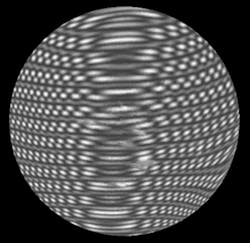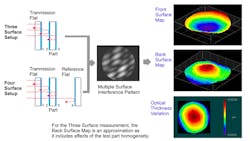Driven by the demand for smaller and smaller consumer products and semiconductor devices, manufacturers need thin planar optics for a host of applications. This means material and optics manufacturers must ensure these small pieces of glass are flat and free of material deformities which can cause distortions and affect the device’s performance.
This places a huge burden on the tools and processes needed to measure and confirm the uniformity of thin planar optics and ensure that they are fit for purpose.
Inherently, measuring thin, parallel optical surfaces can be extremely taxing. The optics are less than a few millimeters thick, and this means the front and back surfaces are very close together. Because of this, standard mechanical phase shifting interferometry (PSI),which was used to examine optics for consumer devices and semiconductors, is now difficult to use on the smaller optics.
A more advanced approach, Fourier-transform phase-shifting interferometry (FTPSI), makes it simpler to characterize the front and back surfaces, variations in optical thickness variation and the homogeneity of the glass itself. FTPSI can distinguish between the front and back surfaces and characterize the quality of both in a single measurement, even if the lens is less than a millimeter thick.
FTPSI Advantages
To understand why FTPSI is the preferred technique for measuring thin parallel optics, let’s take a closer look at the traditional measurement techniques and where they fall short.
In essence, PSI which works by passing a light beam through an ideal reference optic (called a transmission flat, TF) to the part being tested. But when the optics are too thin, this technique cannot distinguish between the front and back surfaces.
When properly aligned, the TF and the part being tested create an interference pattern, which is called an interferogram when recorded. Metrology software analyzes height variations generated by the phase shifts and reconstructs the surface wavefront, which represents the difference in height between the TF and test part.
When the front surface of a thin, parallel part is aligned, the back surface typically sends a second reflection to the interferometer. This results in a complex fringe pattern created by several, overlapping interferograms that cannot be accurately analyzed using PSI.
This could be fixed, but to do so is time consuming and adds unnecessary and potentially damaging steps to the overall process. These include applying black paint to the back surface to extinguish its reflection, coloring it with a dark colored marker or spreading petroleum jelly on the surface.
The FTPSI method makes it unnecessary to manually manipulate the optic’s back surface to get meaningful and accurate measurements. Instead, FTPSI back-surface’s refection to get more information about the optics in a single measurement.
This is possible because FTPSI does not require mechanical motion within the test cavity to create interferograms. Instead, FTPSI relies on wavelength modulation of the laser source to make measurements possible. Each cavity in the optical path in an FTPSI acquisition creates a unique interference frequency that defines its cavity length, and this lets operates clearly delineate and accurately characterize the surface. Algorithms can then analyze both surfaces and characterize their form independently.
FTPSI Basics
A TF is used with an interferometer to establish a plano reference for a surface or transmitted wavefront measurement. A reference flat (RF) is a high-quality optical surface that directs a measurement beam with minimal changes to the overall wavefront.
The simplest FTPSI measurement is a three-surface configuration that consists of the TF (surface 1) and the test part (surfaces 2 and 3). In this configuration, a back-surface result is provided but it includes material non-uniformities because the measurement beam passes through the material of the test part.
For more accurate measurements of the back surface, a four-surface configuration can be used by placing an RF (surface 4) behind the test optic. In this configuration, the form of surface 3 is compared to the known RF. This configuration also creates a second test cavity between the back surface and RF, and provides a direct measurement of the back surface without the uncertainty of the part’s material.
A single FTPSI measurement with both three- and the four-surface cavity configurations includes a thickness deviation result, which is a full-surface map of the material thickness across the test part.
The four-surface cavity configuration can characterize the material homogeneity of the test part, a unique feature of FTPSI.
The homogeneity information can be derived by measuring the cavity with the test part inside, then removing the part from the cavity and performing an “empty cavity” measurement, allowing a comparison between the TF and RF. Unlike homogeneity measurement techniques that only provide nonlinear components, FTPSI results maintain a fixed cavity and, therefore, can provide nonlinear and linear components of the material’s homogeneity. The linear portion is critical for applications sensitive to beam pointing, as the result can be used to predict how a beam deviates when passing through the test part.
Accuracy
As with all interferometric test methods, the measurement uncertainty is based on several factors including the reference optics’ quality, the stability of the measurement environment and mounting techniques.
For parts less than six inches (150 mm) in diameter, the reference optic peak-to-valley surface can be of the order of 2.5% of the wavelength of the light used to make the measurement (λ/40). If the system, for example, has a laser emitting red light at a wavelength of 633 nm, this corresponds to approximately 16 nm. In most cases this enables the resultant measurement to be well within tolerances for thin-glass applications.
How the part is held in the test cavity is probably the most critical factor when measuring thin optics—more specifically the mounting technique and the orientation. Simply clamping a thin optic can induce unwanted stress that bend the optics. Differences in orientation can yield different measurement results, especially for thin parts, due to gravity affects. Ideally, parts should be mounted in the same configuration in which they will be used in their application to avoid unexpected differences between the designed intent and actual performance.
FTPSI is a compelling choice for optics manufacturers who need to ensure the quality of thin, parallel optics. Unlike conventional mechanical PSI, FTPSI can distinguish the front and back surfaces and characterize their corresponding surfaces in a single, repeatable measurement. Thanks to advances in equipment and algorithms, FTPSI can characterize surface form, thickness deviation, and material homogeneity of optics less than 1 mm thick. Faced with the growing demand for thin parallel optics, and the challenges involved in accurately measuring those optics, FTPSI overcomes the limitations of previous methods. Its strength in characterization along with its ease-of-use makes it a good choice for optical metrology.
Dan Musinski is the vice president of Strategic Business Development at Zygo Corp. in Middlefield, Conn. He can be contacted at [email protected].


